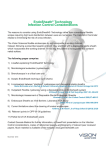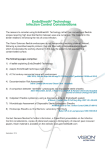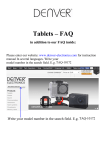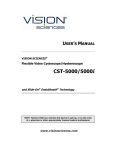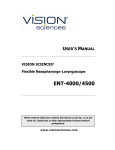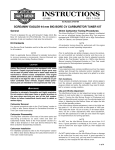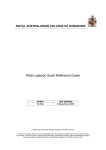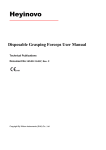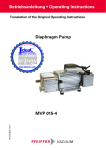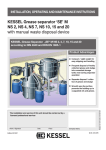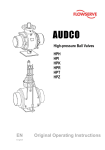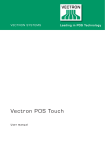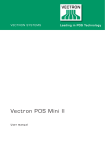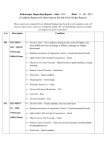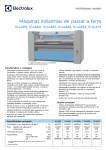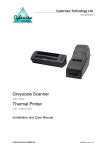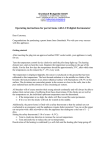Download Vision Sciences Endoscopes and EndoSheath ® Technology
Transcript
Vision Sciences Endoscopes and EndoSheath ® Technology Preparation Wall Chart Endoscopes and EndoSheath® Technology should not be used without a thorough review and understanding of the User’s Manual. Before inserting the Endoscope into the Sheath, ensure that the insertion Tube is Clean, Dry and Undamaged. Review the User’s Manual for Recommended Cleaning procedures for the Endoscope. If setting up for sterile field, double-glove with sterile gloves. Carefully place Sheath contents in sterile field. Double glove, Sterile. Apply drape bag to installation stand Place Sheath into installation stand with accessory port facing out Gently insert Scope into Sheath with the endoscope label facing forward and the flat edge of the insertion tube against the flat edge of the Sheath connector opening The tip of the scope MUST be straight when placing into Sheath. If there is any resistance in loading, verify that the Sheath channel is properly aligned. If the channel is misaligned / twisted, straighten the channel before continuing scope insertion Lock Sheath to Scope by turning knob 900 (horizontal) When using a CV-1.5 Sheath, attach the irrigation source tubing directly to the sheath connector accessory port. Deflect Scope tip to ensure Sheath window is seated properly. Double glove before starting removal process. Re-insert Scope into stand, detach clips and move control Body Cover without contaminating handle. Remove outer gloves. When applicable insert irrigation/suction tube through the flow control valve. Detach irrigation/ suction Tube from the Flow Control Vale and Water Source. Attach the end of the irrigation/suction tube to an irrigation/ suction source. Unlock Sheath rom Scope by Turning the Locking Knob to the Vertical Position. If setting up sterile, remove outer gloves. Unfold cover over control body of Scope and secure with clips. Remove Scope from Sheath. If resistance is felt during removal. STOP, Make sure the sheath and Scope are STRAIGHT and ensure the channel is not wrapped around the insertion tube. Use the drape bag as a barrier between the fingers and sheath, gently grasp the window of the Sheath and remove the Scope WITHOUT rotating the Scope Ready for use. Verify angulation function and water flow/suction before use. Deposit used Sheath and gloves into drape bag and dispose as per hospital policy. Genesis Medical Ltd 7 Trojan Business Park Cobbold Road London NW10 9ST Tel: +44 (0)20 8451 4100 Fax: +44 (0)20 8451 4115 Website: www.genmedhealth.com Remove endoscope from Sheath and place in a clean/Sterile area. Do not handle the endoscope with contaminated gloves After removing the Sheath, Inspect the endoscope insertion tube and distal bending section and confirm these areas are dry and undamaged. If the endoscope was dry when the sheath was fitted it will be dry when removed. If moisture is observed, this could indicate a breach of the sheath and high level disinfection can be considered. If high level disinfection is decided upon, the endoscope must be prepared according to instructions in the user manual. CLEANING AN INTERMEDIATE LEVEL DISINFECTION (after each procedure) Gently wash all external surfaces of the endoscope with an appropriate instrument grade detergent or EndoWipeTM Enzymatic sponge After washing thoroughly rinse the outside of the Endoscope with clean lukewarm water. Wipe down the entire Endoscope with Gauze soaked in 70% ethyl/isopropyl alcohol or an EndoWipeTM Towelette . Ensure full coverage of alcohol Ensure all external surfaces of the Endoscope are dry prior to installing another Sheath. LEAKTESTING TESTING(If(needed if contamination LEAK a leak is suspected & if occurs) high level disinfection is needed) Connect the leak tester to the endoscope’s EtO/vent valve. Push down and rotate the leak tester connector clockwise until it is secured. Pressurise the Endoscope. Ensure leak tester’s valve is closed. Pump the hand bulb until the needle reaches the green section. Maintain pressure for 10 seconds, observing the needle position. Endoscope may require several pumps of the bulb to completely pressurise If the needle position remains steady. Immerse the entire scope in water and observe if for 30 seconds. Angulate the distal bending section up and down while the Endoscope is immersed. The absence of air bubbles confirms the scope is air tight. Remove from water and open the leak tester’s valve. Ensure the needle on the pressure gauge fails to zero and disconnect the leak tester from the endoscope. If the pressure decreases the leak tester connection may be loose or the pressure valve on the leak tester may be open Re-attach the leak tester. If the symptoms persists, contact Genesis Medical. A small stream of bubbles indicates a leak in the endoscope that was not detected by pressure gauge. Do not continue to use a leaking endoscope and contact Genesis Medical for repair. Genesis Medical Ltd 7 Trojan Business Park Cobbold Road London NW10 9ST Tel: +44 (0)20 8451 4100 Fax: +44 (0)20 8451 4115 Website: www.genmedhealth.com Published online before print February 25, 2013 Journal of Clinical Urology February 25, 2013 Urinary tract infection following flexible cystoscopy: a comparison between sterilised cystoscopes and disposable sterile sheaths Steve P McCombie; Jack P Carmichael; Srijit Banerjee; Sarah J Wood Department of Urology, Norfolk and Norwich University Hospital, UK Email:[email protected] Abstract Objective: The objective of this article is to compare the incidence of post-cystoscopy urinary tract infections (UTIs) between cystoscopes sterilised between patients and cystoscopes that use removable sterile sheath technology. Patients and methods: A total of 200 patients undergoing flexible cystoscopy at the Norfolk and Norwich Hospital (Norwich, UK) between November 2011 and March 2012 were identified prospectively as part of an ongoing audit of the department’s services. One hundred patients were recruited from day procedure lists, using KeyMed® cystoscopes sterilised between patients (sterilised scope, SS); 100 patients were recruited from a ‘one-stop’ urology clinic, using a Vision Sciences® CST-5000 cystoscope with disposable sterile Endosheath® technology (removable sheath, RS). Midstream urine (MSUs) samples and patient symptoms were recorded prior to the cystoscopy and at least three days following the cystoscopy. Results: No significant difference was found in the incidence of new MSU-confirmed UTI (2.7% (SS) vs. 2.0% (RS)). In those undergoing their first cystoscopy, no significant differences were found in either new symptoms (34.1% (SS) vs. 36.7% (RS)) or requirement for antibiotics (13.6% (SS) vs. 13.0% (RS)). Conclusion: Flexible cystoscopy using removable sterile sheath technology does not have a higher incidence of UTI compared to a cystoscope sterilised between patients. The introduction of cystoscopes using this technology can therefore safely transform flexible cystoscopy into an outpatient clinic procedure. Acknowledgements Th is w as an in d ep en d en t au d it car r ied o u t b y t h e au t h o r s w it h n o in vo lvem en t o r f u n d in g b ein g p r o vid ed b y KeyMed ®, Visio n Scien ces ®, Tr ist el®, San i-Clo t h ® o r an y o t h er ext er n al so u r ces. Funding Th is r esear ch r eceived n o sp ecif ic g r an t f r o m an y f u n d in g ag en cy in t h e p u b lic, co m m er cial, o r n o t -f o r -p r o f it sect o r s. Conflict of interest Th e au t h o r s d eclar e t h at t h er e ar e n o co n f lict s o f in t er est . Key Points:• To demonstrate that Outpatient flexible cystoscopy was a feasible practice • 27 patients awaiting diagnostic or check cystoscopy in the Leeds area were invited to attend an Outpatient Clinic to evaluate the Vision Sciences CST2000 scope that uses the Endosheath system • The performance of the system was evaluated and patient feedback obtained through questionnaire • The results were positive indicating Outpatients scenario was ideal for flexible cystoscopy of this nature • The system was rated highly for image quality, ease of use and handling • Patients complimented the service and preferred Outpatient setting to day-ward or theatre based procedure Conclusions:• The Vision Sciences system makes it possible to perform outpatient flexible cystoscopy, economically and efficiently with the aid of a disposable Endosheath system Genesis Medical Ltd 7 Trojan Business Park Cobbold Road London NW10 9ST t 020 8451 4100 f 020 8451 4115 e [email protected] www.genmedhealth.com Infection Control of Sheathed Scopes as raised in the CfPP 01-06 guidelines - Issues relating to Vision Sciences (VSI) Flexible Endoscopes Decontamination of flexible endoscopes: Operational management manual This document is not produced in any way in conjunction with the DoH. What is the CfPP document? The CfPP published guideline ‘offers best practice guidance on the management and decontamination of flexible endoscopes… ‘(14304 – Page 6). ‘It supersedes the relevant parts of (HTM) 2030 document...’ Page 7. The structure of the document is to divide in to five key areas. Vision Sciences are not a producer of EWD [endoscope washer disinfectors] so these are not discussed except in relation to their use with VSI endoscopes. 14091/14188 (Page 49/50) looks specifically at non-channelled Nasendoscopes. It states that because of the nature of their use, these non-channelled scopes are manually cleaned with an appropriate medical grade, endoscopic disinfectant. Vision Sciences endoscopes are non-channelled so these guidelines apply. In addition, as these scopes are non-channelled they also do not require the use of drying cabinets due to the possibility of bacterial contamination on their surface not being replicated in the absence of liquid water. It also states that ‘as long as direct or indirect recontamination with patient body fluids does not occur, no maximum time of storage before reprocessing can be specified.’ These key statements in relation to ALL VSI endoscopes using Endosheath® Technology VSI scopes are also channel-less and as such can be considered in the same way whether it is in Bronchoscopy, Cystoscopy, Trans Nasal Oesophagoscopy and of course Nasendoscopy On discussion with some leading UK based experts in decontamination that these principals can apply to all VSI endoscopes regardless of therapeutic area. On review of the validated processes and protocols outlined by VSI, the experts agreed the Endosheath® Technology maintained the highest levels of patient and user safety Contact details of the experts are available on request for validation of these opinions What is the VSI Endosheath® product offering? VSI Endoscopes are channel-less flexible endoscopes over which a specific external Endosheath® is fitted This provides a sterile insertion tube in contact with the patient rather than (usually) a high level disinfected scope provided by the EWD. The Endosheath®/endoscope combination means the scope never directly makes contact with the patient. The sterile working channel is incorporated in the Endosheath® and never touches the endoscope Each Endosheath® provides a single use sterile product The working channel is new and sterile for each patient The risk of cross contamination is vastly reduced because the working channel is disposed of after each case CfPP guidelines – specific points of relevance Personnel Section 14069(Page 9) states Training should be provided for all staff involved in the decontamination of flexible endoscopes. Genesis Medical provides comprehensive training packages in the form of presentations, supporting materials and training competencies for the users of its products, to ensure they are fully equipped to use the product correctly and in accordance with the validated protocol. Types of EWD and cycles Section 14073/14165 (Page 17) discusses the use of EWD devices. VSI Endoscopes can be re-processed in an EWD Like all manufacturers of endoscopes, VSI would firstly ensure chemical compatibility and functional compatibility with the specific EWD Size and Numbers of EWD’s Section 14076/14168 (Page 23) discusses the need to assess how many EWD’s a facility may require. There is no formal requirement for VSI scopes to undergo EWD reprocessing between every case (providing the endoscope is not grossly contaminated) The overall number of EWD machines required may be reduced as the main reason for multiple EWD’s is to maintain efficiency within the Endoscopy service on offer (and indeed Endoscopes as highlighted in section 14169 and 14170.) (Page 24) VSI scopes are reprocessed in between cases using a validated protocol consisting of intermediate level disinfection cleaning regime combined with an aseptic technique for loading a sterile Endosheath® for each patient highlighted in sections 14169 and 14170 (Page 24). Reprocessing 14078/14173(Page 27) points to the use of disposable or re-usable reprocessing accessories, such as cleaning brushes, cleaning tools, endoscope valves and water bottles. The guidelines refer to the need to for single use items, which can incur additional cost. Reusable items for these purposes also incur on-going costs as functional inventory must be maintained, meaning additional cleaning and maintenance costs. VSI scopes have no channels and removes the need for many of these items EWD operation, and endoscope storage and transportation 14083 (Page 33) points out the difficulties in inspection of flexible endoscope long narrow lumens (working channels) and that these require connection to the EWD. VSI endoscopes circumvent these difficulties by removing the working channel from the endoscope and placing them as a single use sterile working channel within the Endosheath® Decontamination of Endoscopes 14186 (Page 41/42) discusses the need of the user to follow the manufacturers’ guidelines for cleaning. VSI provides this in data form, presentation/visual aids and formal training competency documents Conventional channelled endoscopes require essential manual cleaning due to the direct contact with the patient VSI endoscope cleaning is prophylactic when used with the Endosheath® in accordance with the manufacturer’s guidelines. 14187(Page 42) discusses in depth the process stages of an EWD This is 9 specific points which must be performed exactly in order to prevent failing the cycle or alarming the EWD due to incorrect set up - VSI endoscopes removes this issue. 14190 (Page 45/46) highlights issues in the transportation of HLD cleaned flexible endoscopes Additional equipment (transportation trays with a two covers) is required for moving contaminated/decontaminated endoscopes. These trays will also require cleaning and decontamination. Using VSI endoscopes that do not require the routine use of EWD’s removes the issues highlighted here with transportation Decontamination of Nasendoscopes 14091/14188 (Page 49/50) looks specifically at non-channelled Nasendoscopes. It states that because of the nature of their use, these non-channelled scopes are manually cleaned with an appropriate medical grade, endoscopic disinfectant. Cleaning should also be undertaken irrespective of the use of covering sheaths, but crucially does not exclude the use of such sheaths. In addition, as these scopes are non-channelled they also do not require the use of drying cabinets due to the possibility of bacterial contamination on their surface not being replicated in the absence of liquid water. It also states that ‘as long as direct or indirect recontamination with patient body fluids does not occur, no maximum time of storage before reprocessing can be specified.’ These are significant and key statements in relation to ALL VSI endoscopes using Endosheath® Technology VSI scopes are also channel-less and as such can be considered in the same way whether it is in Bronchoscopy, Cystoscopy, Trans Nasal Oesophagoscopy and of course Nasendoscopy On discussion with some leading UK based experts in decontamination that these principals can apply to all VSI endoscopes regardless of therapeutic area. On review of the validated processes and protocols outlined by VSI, the experts agreed the Endosheath® Technology maintained the highest levels of patient and user safety Contact details of the experts are available on request for validation of these opinions Sections 14095 (Page 56) to 14099/14206 (Page 65) look at chemical compatibility with EWD’s as well as enzymatic detergents, and flexible endoscopes A full list of compatibility is available upon request VSI endoscopes are generally compatible with the common used chemicals in the UK. Traceability All VSI Endosheath® packaging have tracking LOT number labels in triplicate on the exterior of the sterile package Endosheath® Tracking can then be maintained to the highest standards, in addition to any tracking/traceability brought about by periodic use of the EWD system An example of the Journey of an endoscope through the system Section 14218 (Page 76) outlines the manual cleaning phase of scope reprocessing, VSI endoscopes do not require routine use of EWD systems Section 14218 outlines the manual cleaning phase of scope reprocessing, which can be maintained with the Vision Sciences’ scopes. The process would routinely change to the appropriate protocol for the specific endoscope and Endosheath® combination being used, as outlined in the training competencies and resources provided by VSI IF gross contamination is suspected or the local protocol dictates periodic use of the EWD system then this can be conducted in accordance with CfPP 0106’s guidelines. Summary The unique nature of the VSI Endosheath® Technology aseptically fitting sterile sheaths incorporating the working channels on the Vision Sciences non-channelled scopes are different from traditional channelled flexible endoscopes. Sheaths fitted over non-channelled scopes are acceptable in the document. This means that Clinicians can be assured of maintaining adherence to the guideline, whilst significantly reducing risk of cross biocontamination and improving operating efficiency.





























